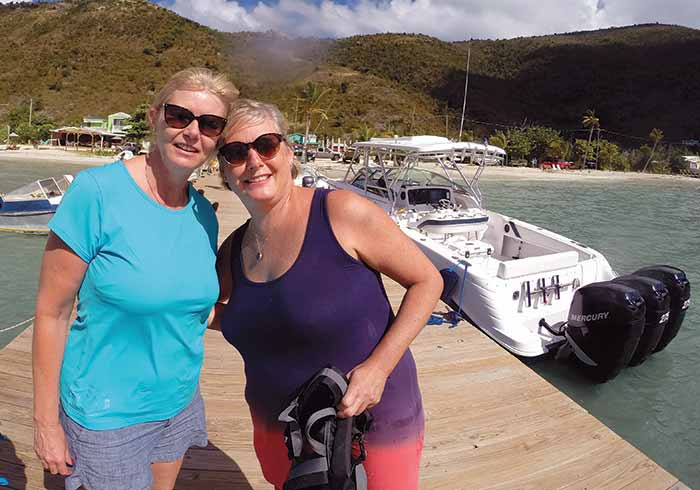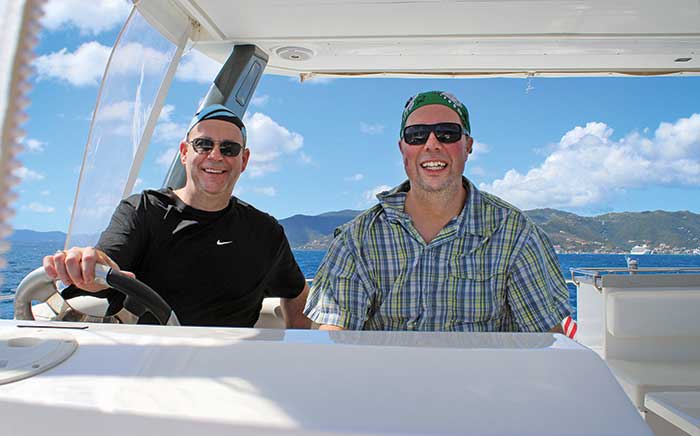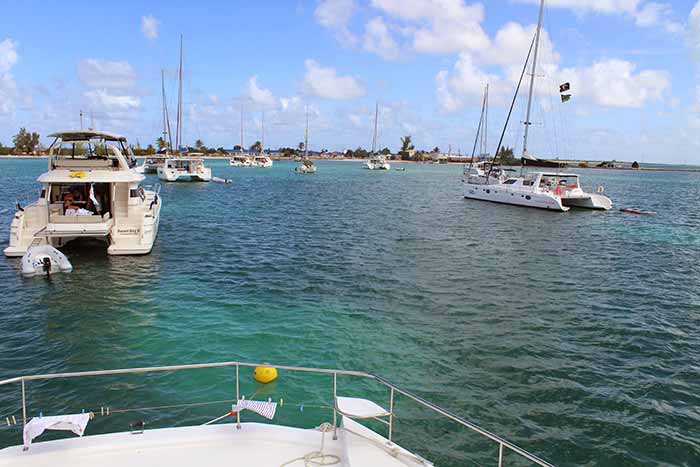Advertisement
There's good reason why the British Virgin Islands are considered the best cruising grounds on the planet. But you won't know, unless you go!

Photo: The Moorings
Countless magazine articles and travel guides describe the British Virgin Islands as a patch of paradise — a stunningly beautiful Caribbean archipelago of lush, unspoiled volcanic islands that rise out of clear azure water. They’re right. The BVI is made up of more than 50 islands — only about 15 inhabited — offering line-of-sight island hopping, where you can overnight in a new anchorage each day. From November through January, the prevailing wind is steady from the northeast at 15 to 20 knots — a sailor's paradise, and sailboats clearly rule this playground.
But I'm no sailor, and I wanted to skipper my own boat. So in January 2019 we opted to charter a 43-foot power cat named Sea La Vie through The Moorings, the venerable 50-year-old charter company with more than 400 boats at 20 destinations worldwide. The BVI is its largest and most popular base with a 200-boat fleet based on Tortola, the largest of the islands.
Meet The Crew
On board were my wife, Rhiannon, and our friends, Helen and Dave. We arrived in San Juan, Puerto Rico, took a puddle-jumper to the airport on Beef Island, then a shuttle run to The Moorings' marina in Road Town, Tortola.

Helen and Rhiannon, the respective galley rat and cook (roles they cheerfully embraced), still talk about the experience nearly a year later.
None of us quite knew what to expect, adding to the excitement. What The Moorings does well is set your mind at ease. As the responsible skipper, I attended the mandatory captains' meeting, which was crucial to learning the do's and don'ts. "You can anchor on the south side of Peter Island, but overnight on the north side in Great Harbor. ... On Cooper Island, avoid the seabed grass, and don't anchor in more than 15 mph. ... If you're planning to visit White Bay on Jost Van Dyke, follow the marked channels through the reef to anchor. There are no moorings there and a decent swell, so overnight anchoring is discouraged. ..." My notebook filled with great advice and itinerary tips, the invaluable local knowledge I was craving.
I'm a powerboater most comfortable on 20-something runabouts. I'd never skippered a power cat. No worries. Our friendly skipper, Roy, paid us a visit the first night we spent on the boat, at the marina, and ran us through boat systems (electrical panel, freshwater, holding-tank systems, and so on). Early the following morning, he accompanied us out into the harbor to practice anchoring and picking up a mooring ball.

The captain and first mate revel at steaming at 18 knots toward the next port of call.
"You can do this!" Roy cheered us repeatedly — and he was right, as first mate Dave and I developed teamwork with me at the flybridge helm, taking his directional signaling as we crept up to a mooring ball, he hooked the line and cleated two bowlines 6 to 8 feet from the ball. Piece of cake!
Provisioning
We provisioned ahead through The Moorings' new provisioning website — simple, with easy-to-cook meal suggestions. Your provisions will be delivered in plastic cases; run down the list to ensure everything was delivered. The site even allows splitting the cost of the provisions per person or per couple.
Alternatively, provision yourself on day one of the charter, as soon as you're allowed aboard your boat, at the well-stocked local supermarket right near The Moorings' base, which also sells liquor. Bring your own spices from home.
Away We Go
The delayed start soon reminded me of a critical piece of advice at the captains' meeting: "Get up early to get a good mooring at the next harbor." The mooring field at Manchioneel Bay on Cooper Island (a straight 5-mile shot southeast across Sir Francis Drake Channel) was full by lunch. No worries. We headed northeast instead, up the island chain. While conditions are fairly consistent in the BVI, expect to alter your itinerary. Each port and anchorage has its own rewards, so you really can't lose.
As we moved on that afternoon, Sea La Vie, with its twin 260-hp Yanmar engines, showed its worth. Twelve knots? Easy. Seas were calm, so we were comfortably running at 17 to 18 knots ("See ya later, sailboats!") and quietly absorbed the view of spectacular velvety green mountains in this extraordinary wonderland. We ran past Ginger Island to Virgin Gorda, nabbed a mooring ball, then dinghied ashore to the famed Baths, a geological phenomenon of massive granite boulders that shelter sea pools on the beach's edge. We swam and snorkeled the reef, wondering how this otherworldly oasis was created.

The mooring fields are bustling in the morning as new arrivals search for the best location while locals ferry out ice and collect overnight fees.
Anxious to park ourselves — The Moorings prohibits running at night — we cruised to the north end of the island, around Mosquito Island, and into hopping Leverick Bay. The mooring field was crowded, but we picked up one of the last balls and unwound over cocktail hour. How did we pack so much into one day? Our pace, from here on out would be considerably more chill. It was time to fire up the grill and my custom playlist of reggae tunes. The laughter came easy as we drifted into island time under clear skies and a full moon.
While BVI conditions are fairly consistent, be prepared to alter your itinerary.
Anegada da Vida, Baby
A rooster crowing and water lapping on the hull was our wake-up call — time to rise and shine. The sun comes early here, along with the overnight showers that propelled me into a frantic closing of boat hatches every night before quickly falling back to sleep to the gentle patter of drizzle. Today was the big day.
Flat as a pancake, Anegada is the northernmost (and most unique) of the BVI, the only one formed of limestone and coral. We could barely find it in the distance as we set off on the 17-mile run northeast at 18 knots, but we set our instruments and our view to the place on the horizon that we knew it would be, and were there in an exhilarating 60 minutes.
We were barely tied up when we were greeted by Barry, a chef at the Lobster Trap restaurant who also collects the $30 overnight mooring fee. His smile was contagious, and when he mentioned he was 65, we asked how that's possible. "I don't worry about anything," he said, grinning from his dinghy. "Take any negative and turn it into a positive." Turns out those stories about an island vibe are not exaggerations.
Taking the advice of a BVI veteran, we planned to dinghy ashore and take a taxi to the north shore for some excellent snorkeling at Loblolly Bay. But the crew seemed very content to stay put and absorb our first full day on a mooring. The waters surrounding the island are shallow, aquamarine, and full of coral heads, streaking the water with different shades of blue. We drank dark 'n' stormies, watched someone kite surfing around the harbor, and took swims off the boat. A seabird landed on our flybridge to see about a free meal. Captain's ruling: "We're spending two days here," I said.
Tip
Visit BoatUS.com/Charter-Packing-Tips for a comprehensive list of chartering must-brings.
"I'm not going anywhere," said first mate Dave, looking out at the horizon. "They can come get their boat. I'm staying in Anegada."
Our friend was right about the snorkeling at Loblolly Bay. The 20-minute taxi ride (actually bench seating in the back of a pickup) from the Anegada Reef Hotel took us past roaming roadside cows, goats, and a pond of flamingos. We donned snorkeling gear and waded into the warm waters to explore reef after reef, home to a riot of fish. A local fisherman and his partner were emptying their traps of spiny lobsters to be served later that night at one of the island restaurants. If you're only going to dine out a few times, Anegada is a great place to do it.
Things We Wish We'd Known
With bareboating, you control nearly every aspect of your itinerary. With great power, comes great responsibility. Accept the inevitable gaffs, laugh at yourself, and learn. Here are a few nuggets of wisdom.
- We were there to get off the grid and had no regrets about unplugging. But for $280, you can rent a mobile Wi-Fi router. Unless you're obsessed with posting photos in real time, or have an unlimited data plan, wait until the free Wi-Fi at the base or at most restaurants or marinas you visit. The Moorings offers free Wi-Fi on select yachts.
- There are plenty of outlets on board for recharging; the 110V/60Hz electricity is the same as U.S./Canada.
- For daily weather reports, call the base (free) on the complimentary cellphone that comes with the boat; or check local radio stations 92.3 FM and 780 AM.
- Hail restaurants on Ch. 16 (I know, sacrilegious, but this is the BVI), then move to whatever channel they request. The Moorings monitors VHF Ch. 12.
- Ice is essential. Our boat had a refrigerator and freezer, but the freezer is likely to be full of food. The Moorings will provide a chest cooler. Mornings in each port, someone will dinghy through the harbor offering bags of ice for $10 or $20 (depending on the size). We bought ice each day. The ice deliverers will often take your trash.
- A dry bag is essential for dinghying ashore with cellphones and cameras. You'll be tempted to go barefoot. Don't. Wear some sort of footwear. One sliced foot ruins a holiday.
- Most places take credit cards but cash in hand goes a long way, and the locals prefer it (restaurants and bars don't care). Local currency is the U.S. dollar, happily accepted everywhere. Each couple on our boat brought about $500 in cash — more than enough.
- Several marinas sell fuel. We had plenty throughout the week, ending with 70% of our original 265 gallons. Our little red dinghy gas tank was about half full at the end. Fuel was no issue for our generator either; we never turned on the AC.
- We ran out of freshwater on the last morning, but attribute that to getting lazy with longer showers. Our power cat had two 100-gallon water tanks.
- Free basic snorkel gear is provided by most charter bases, including The Moorings.
- Warm trade winds mask the sun's heat; you won't realize you're getting sunburned. Use plenty of waterproof sunscreen.
- Rain showers can be heavy at certain times of the year. Pack a lightweight, waterproof jacket.
- Book flights home for the afternoon so can spend your last night aboard in a pretty anchorage, rather than at the charter dock the night before to catch an early taxi to the airport. (The Moorings will arrange transportation.)
- Prioritize a few "must-do's," chill, and let the rest of your itinerary unfold as you go. You can't possibly take it all in on a one-week charter.
Long Haul To Jost
The captain (yours truly) got a little cocky for our longest leg: a 28-nautical-mile "beeline" from Anegada to Jost Van Dyke. Why not? We'd all grown comfortable and slipped into our on-board responsibilities. Unfortunately, the day brought our worst conditions of the week, with the wind shifting to the east, picking up to 15 to 20 knots, and kicking up some 4- to 6-foot confused seas. I tried to muscle through at 10 knots but was rewarded with slaps of spray to the face up in the flybridge, and broken plates knocked off the galley counter. Lesson learned. Stow before you go, and throttle back. This would be a 5-knot slog.
After finally finding the lee along Tortola's north shore, we were all a little weary from two-plus hours of rocking and rolling, so it was time to follow another tip about a hideaway not on The Moorings basic itinerary. Jost would wait another day. Cane Garden Bay, tucked into the southwest shore of Tortola, welcomed with high, rolling green hills speckled with colorful pink and blue houses embedded in the near-vertical hillside. The harbor is protected, but gentle rollers creep in, and the seabed creates surfable waves. We watched more than a dozen surfers riding breakers into the harbor. The sun was out again, and all was right with the universe.

We proudly flew the BoatUS burgee from our flybridge (aka "sky lounge").
We dinghied ashore to nose around, landing at Quito's Gazebo, lucky to find it was a night when the proprietor and local recording star Quito Rymer was performing his blend of island music. Painkillers never tasted so good. We shared one with the former bass player from Supertramp, a favorite rock band from my youth. At least that’s what he told us, and his detailed story meshed with my memory. You never know whom you'll meet in the BVI.
The next morning brought an easy 30-minute run to Jost Van Dyke's Great Harbour. We dinghied ashore for some walking and window shopping, and stopped by the legendary Foxy's Bar, but was too early in the day to settle in, even by island standards. We had bigger plans, again going on good local advice. We dinghied out of the harbor, hung a right, and hugged the shore into the unprotected but spectacular White Bay. The powder-white beach is made for digging your toes into the sand, and slopes gently down into a sandy bottom that makes for great swimming in rolling waves. Beach bars line the waterfront, including the infamous Soggy Dollar, supposed birthplace of the aforementioned painkiller. By the time we were back aboard for the evening, the crew again revised our list of favorite spots, moving White Bay to the top.
When To Go
December through February is the most reliable three-month stretch for the trifecta of sunny skies, pleasant breezes, and very little rain. Temperatures linger in the 70s and 80s, with steady 15- to 20-knot northeast wind. In February, winds move to the east; by June to the southeast at 10 to 15. Trade winds are weakest in September and October, when weather can be less settled.
Last Stop, Norman Island
From Jost, we had to get back toward the base camp on the other side of Tortola, through a channel to the south named The Narrows (not as narrow or intimidating as it sounds) dividing the BVI from the U.S. Virgin Islands' St. John. We spent our last night off Norman Island tucked into The Bight, a beautiful well-protected harbor. Norman is known for its numerous caves just outside The Bight, at aptly named Treasure Point, as the caves were allegedly used by pirates and smugglers in days past. Today, it welcomes snorkelers and kayakers.

A hike to the top of Norman Island rewards with a breathtaking vista.
This quiet island is uninhabited by anything other than birds, wild goats, and other critters. Young palm trees have been planted along the beach, and one modest restaurant-bar (Pirates Bight) opened about a year earlier — a most welcome anchorage for our final day. We dinghied ashore for some snorkeling over a reef just a few feet off the beach, mulling over the stark reality that our adventure was winding down. Later, hiking up a winding trail to the ridge, we stared out at the vista of island after perfect island floating in crystal-blue seas, and felt on top of the world.
